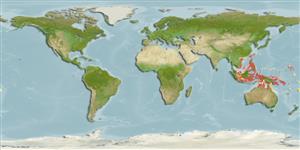Environment: milieu / climate zone / profondeur / distribution range
Écologie
marin; eau douce; saumâtre pelagic-neritic; amphidrome (Ref. 51243). Tropical; 27°N - 21°S
Western Pacific: Ryukyu Islands to New Caledonia.
Taille / Poids / Âge
Maturité: Lm ? range ? - ? cm
Max length : 23.0 cm SL mâle / non sexé; (Ref. 7050)
Épines dorsales (Total) : 11 - 12; Rayons mous dorsaux (Total) : 10 - 11; Épines anales: 3; Rayons mous anaux: 8 - 9.
Body shape (shape guide): fusiform / normal.
Adults inhabit salt and brackish waters of bays and estuaries, penetrating into fresh water (Ref. 1601). Juveniles are sometimes found in streams within 5-10 km of the sea (Ref. 2847). Eggs are guarded and fanned by the male parent (Ref. 205).
Life cycle and mating behavior
Maturité | Reproduction | Frai | Œufs | Fécondité | Larves
Eggs are guarded and fanned by the male parent (Ref. 205).
Masuda, H., K. Amaoka, C. Araga, T. Uyeno and T. Yoshino, 1984. The fishes of the Japanese Archipelago. Vol. 1. Tokai University Press, Tokyo, Japan. 437 p. (text). (Ref. 559)
Statut dans la liste rouge de l'IUCN (Ref. 130435: Version 2025-1)
Menace pour l'homme
Harmless
Utilisations par l'homme
Pêcheries: intérêt commercial mineur; Aquaculture: probable utilisation future
Outils
Articles particuliers
Télécharger en XML
Sources Internet
Estimates based on models
Preferred temperature (Réf.
123201): 26.6 - 29.2, mean 28.7 °C (based on 1282 cells).
Phylogenetic diversity index (Réf.
82804): PD
50 = 0.5312 [Uniqueness, from 0.5 = low to 2.0 = high].
Bayesian length-weight: a=0.01288 (0.00590 - 0.02812), b=3.04 (2.86 - 3.22), in cm total length, based on LWR estimates for this (Sub)family-body shape (Ref.
93245).
Niveau trophique (Réf.
69278): 3.0 ±0.37 se; based on food items.
Résilience (Réf.
120179): Haut, temps minimum de doublement de population inférieur à 15 mois (Preliminary K or Fecundity.).
Fishing Vulnerability (Ref.
59153): Low vulnerability (18 of 100).
🛈
